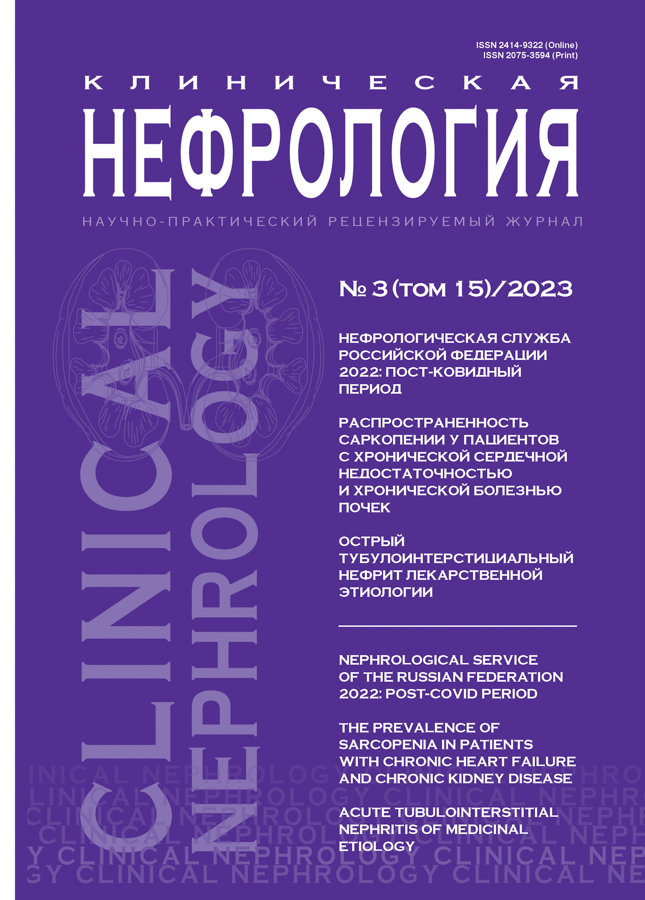The significance of TNF-α in the pathogenesis of protein-energy malnutrition in patients on program hemodialysis
- 作者: Yakovenko A.A.1, Lavrishcheva Y.V.2, Rumyantsev A.S.3, Belskikh A.N.4
-
隶属关系:
- Pavlov University
- Almazov National Medical Research Center
- Saint Petersburg State University
- S.M. Kirov Military Medical Academy
- 期: 卷 15, 编号 3 (2023)
- 页面: 24-29
- 栏目: Original Articles
- URL: https://journals.eco-vector.com/2075-3594/article/view/624723
- DOI: https://doi.org/10.18565/nephrology.2023.3.24-29
- ID: 624723
如何引用文章
详细
Objective. Assessment of the relationship between the blood serum tumor necrosis factor α (TNF-α) level and indicators of protein-energy malnutrition in patients on program hemodialysis (PH).
Material and methods. 645 patients on PH, including 300 men and 345 women aged 56.8±12.8 years were examined. All patients received treatment with program hemodialysis for 8.4±5.3 years. The assessment of nutritional status for the purpose of diagnosing protein-energy malnutrition (PEM) was performed using the method proposed by ISRNM (International Society of Renal Nutrition and Metabolism). Determination of the blood serum TNF-α level was carried out using a method based on a three-stage "sandwich" version of enzyme-linked immunosorbent assay with mono- and polyclonal anti-TNF-α antibodies using commercial kit "alpha-TNF ELISA-BEST", Vector-Best Company, Russia, in accordance with the manufacturer's instructions. Reference values for TNF-α were 0–8.1 pg/mL.
Results. The prevalence of PEM diagnosed by the ISRNM method was 24.9% (160 patients). Mean values of TNF-α in patients without signs of PEM were 7.11±3.02, and in patients with PEM they were more than twofold higher - 19.5±5.9 (P<0.001). Patients with elevated TNF-α levels showed statistically significantly lower values of the main indicators of PEM (body mass index, skeletal muscle mass index, percentage of body fat, as well as total protein, albumin, prealbumin, total cholesterol, transferrin, and the number of blood lymphocytes) than in patients with normal TNF-α levels. A significant relationship between the adequacy of the HD dose (spKt/V) and the TNF-α level was not revealed, which was confirmed, in particular, by the Spearman correlation coefficient (Rs=0.012; P=0.754). At the same time, no relationship was found between the TNF-α level and the duration of HD (Rs=0.038; P=0.328).
Conclusion. The prevalence of PEM diagnosed by the ISRNM method in patients on PH was 24.9%. An increase in the blood serum TNF-α level may be an important pathogenetic link in the development of PEU in patients receiving treatment with PH.
全文:
作者简介
Aleksandr Yakovenko
Pavlov University
编辑信件的主要联系方式.
Email: leptin-rulit@mail.ru
ORCID iD: 0000-0003-1045-9336
Cand.Sci (Med.), Associate Professor at the Department of Nephrology and Dialysis
俄罗斯联邦, 6-8 Lev Tolstoy st., Saint Petersburg, 197022Yuliya Lavrishcheva
Almazov National Medical Research Center
Email: lavrischeva@gmail.com
ORCID iD: 0000-0002-3073-2785
Cand.Sci (Med.), Associate Professor at the Department of Faculty Therapy with the Clinic
俄罗斯联邦, 2 Akkuratov st., Saint Petersburg, 197341Aleksandr Rumyantsev
Saint Petersburg State University
Email: rash.56@mail.ru
ORCID iD: 0000-0002-9455-1043
Dr.Sci. (Med.), Professor at the Department of Faculty Therapy, Faculty of Medicine
俄罗斯联邦, 7/9 Universitetskaya embankment, Saint Petersburg, 199034Andrey Belskikh
S.M. Kirov Military Medical Academy
Email: vmeda_12@mil.ru
ORCID iD: 0000-0002-0421-3797
Dr.Sci. (Med.), Professor, Corresponding Member of the Russian Academy of Sciences, Head of the Department of Nephrology and Efferent Therapy, S.M. Kirov Military Medical Academy
俄罗斯联邦, 6 Academician Lebedev st., Saint Petersburg, 194044参考
- Carrero J.J., Thomas F., Nagy K., et al. Global Prevalence of Protein-Energy Wasting in Kidney Disease: A Meta-analysis of Contemporary Observational Studies From the International Society of Renal Nutrition and Metabolism. J. Renal Nutr. 2018;28(6):380–92. doi: 10.1053/j.jrn.2018.08.006.
- Kramer A., Pippias M., Noordzij M., et al. The European Renal Association - European Dialysis and Transplant Association (ERA-EDTA) Registry Annual Report 2016: a summary. Clin. Kidney J. 2019;12(5):702–20. doi: 10.1093/ckj/sfz011.
- Cooper B.A., Penne E.L., Bartlett L.H., Pollock C.A. Protein malnutrition and hypoalbuminemia as predictors of vascular events and mortality in ESRD. Am. J. Kidney Dis. 2004;43(1):61–6. doi: 10.1053/j.ajkd.2003.08.045.
- Kang S.S., Chang J.W., Park Y. Nutritional Status Predicts 10-Year Mortality in Patients with End-Stage Renal Disease on Hemodialysis. Nutrients. 2017;9(4):399. doi: 10.3390/nu9040399.
- Fouque D., Kalantar-Zadeh K., Kopple J., et al. A proposed nomenclature and diagnostic criteria for protein-energy wasting in acute and chronic kidney disease. Kidney Int. 2008;73(4):391–98. doi: 10.1038/sj.ki.5002585.
- Obi Y., Qader H., Kovesdy C.P., Kalantar-Zadeh K. Latest consensus and update on protein-energy wasting in chronic kidney disease. Curr. Opin Clin. Nutr. Metab. Care. 2015;18(3):254–62. doi: 10.1097/MCO.0000000000000171.
- Gregg L.P., Carmody T., Le D. et al. A Systematic Review and Meta-Analysis of Depression and Protein-Energy Wasting in Kidney Disease. Kidney Int Rep 2020;5(3):318-330. doi: 10.1016/j.ekir.2019.12.009.
- Kanazawa Y., Nakao T., Murai S., et al. Diagnosis and prevalence of protein-energy wasting and its association with mortality in Japanese haemodialysis patients. Nephrology (Carlton). 2017;22(7):541–47. doi: 10.1111/nep.12814.
- Perez V.B., Costa Teixeira Caramori J. Are Nutritional Composed Scoring Systems and Protein-Energy Wasting Score Associated With Mortality in Maintenance Hemodialysis Patients? J. Ren. Nutr. 2016;26(3):183–9. doi: 10.1053/j.jrn.2015.11.003.
- Sabatino A., Regolisti G., Karupaiah T., et al. Protein-energy wasting and nutritional supplementation in patients with end-stage renal disease on hemodialysis. Clin. Nutr. 2017;36(3):663–71. doi: 10.1016/j.clnu.2016.06.007.
- Kang S.S., Chang J.W., Park Y. Nutritional Status Predicts 10-Year Mortality in Patients with End-Stage Renal Disease on Hemodialysis. Nutrients. 2017;9(4):pii: E399. doi: 10.3390/nu9040399.
补充文件







